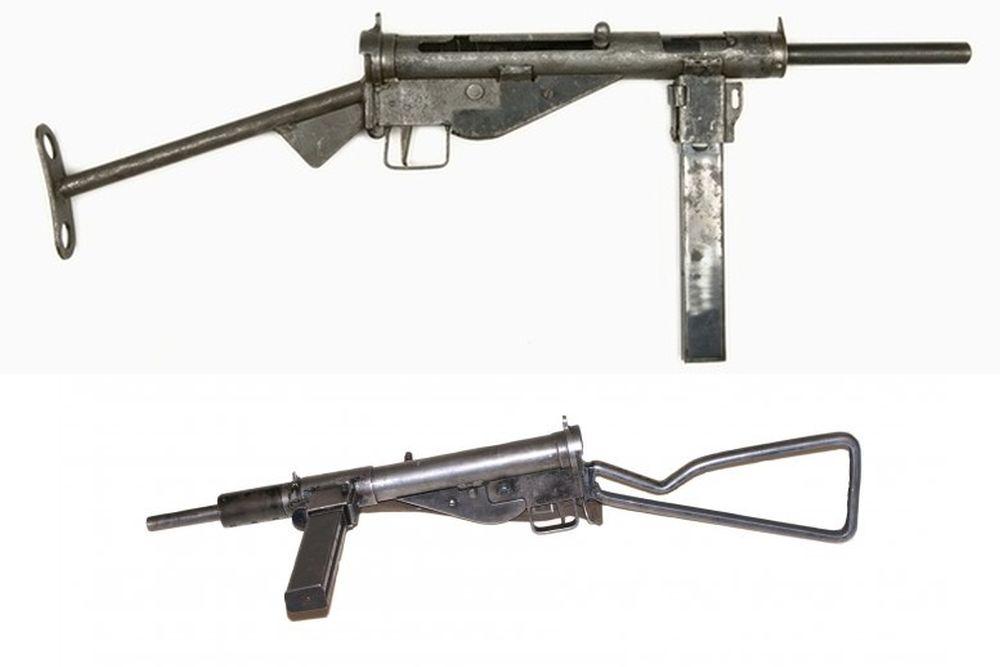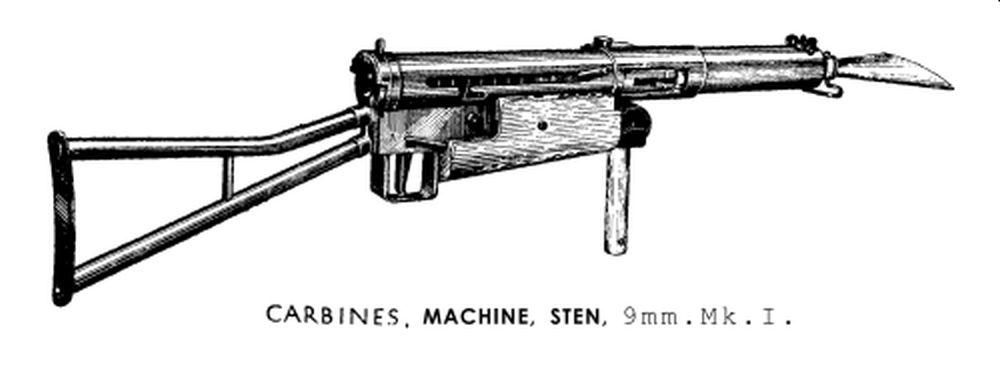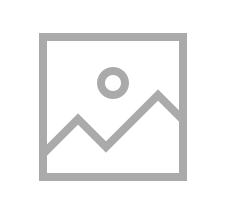Introduction
If there is one particular Allied weapon that appeals to the imagination, it is the Stengun; one of the world's most famous submachine guns. The weapon was produced in enormous quantities and has several types, including German ones. After the Second World War, the weapon is prominently present in almost every film about resistance actions, a fact that has certainly contributed to the myth about this weapon. In this article we try to summarize the facts: the origins, the various types and its use.
Definitielijst
- resistance
- Resistance against the enemy. Often also with armed resources.
History
The experiences acquired during the early stages of the Second World War had intensified the demand for a submachine gun. Great Britain did not yet possess such a weapon at the time, contrary to the United States and Germany. A second problem arose after the hasty departure of the British Expeditionary Forces from France during the evacuation of Dunkirk when the British army had to leave behind almost all its weapons and supplies. At the end of 1940, the Ministry of Supply commissioned the British manufacturer Enfield to produce a weapon that had sufficient qualities but with as little money, material and manpower as possible.
At Enfield, the order was passed to the development team led by Major R.V. Shepherd and designer H. Turpin. Both had already acquired the necessary expertise in developing weapons. Shepherd was involved in the development of the Colt/Browning 0.303" aircraft machine gun and the Brengun, while Turpin came from the Vickers company. Together they had tried to develop a weapon called the Lanchester, using a captured German MP 28/II. Based on the original technical drawings, they had started to develop a simpler design. With the new task at hand, they now decided to come up with an entirely new design.
Turpin took the first steps on December 2, 1940, by proposing a new trigger mechanism that was surprisingly simple. Based on the weapon requirements that he subsequently formulated, he came up with a design that was no less than fifteen times cheaper than the production of an American Thompson machinegun. Enfield soon received permission from the ministry to complete the design for Project T-40 (Turpin 1940). The first sample was ready in less than a week. After some development work at Enfield, the first prototype was produced on January 8, 1941, the T-40/1. After exhaustive testing of this prototype and subsequent minor modifications, a serviceable version was created, the T-40/2.
The Stengun was widely used in all theatres of war. Many countries also issued this weapon as standard to their armies during and after the war. The Netherlands even tested the Stengun in the Dutch East Indies, prior to the outbreak of the Pacific War. However, due to the Japanese invasion, the test was confined to two samples only. Nevertheless, the Stengun was soon introduced into the Dutch navy. Later, the weapon was also issued to the Dutch Prinses Irene Brigade.
Definitielijst
- Brigade
- Consisted mostly of two or more regiments. Could operate independently or as part of a division. Sometimes they were part of a corps instead of a division. In theory a brigade consisted of 5,000 to 7,000 men.
- Browning
- American weapon’s designer. Famous guns are the .30’’ and .50’’ machine guns and the famous “High Power” 9 mm pistol.
Stengun Mk I
On March 6, 1941, the factory received its first order for 100,000 units. The Mk I was a very simple weapon. It was constructed entirely of stamped material and had a metal, open "skeleton" stock. The wooden forward grip could be folded away, and the gunstock was also made of wood. This type still had a flash suppressor. The first weapons, with the formal name of "Carbine Machine Sten Mk I", were delivered to the combat troops in October 1941. The designers were "honoured" by means of the acronym (S(hepherd) T(urpin) EN(field)), whereby ‘Enfield’ stood for the location of the Royal Small Arms Factory (RSAF) in a part of London called Enfield Lock
The Mk I was formally introduced into the army on March 7, 1941. Production was taken over by the Singer Manufacturing sewing machine factory. After the first batch, another order for 100,000 units followed. The weapons were marked with the manufacturing brand’s initials S.M.C. and the code number 67.By having removed the grip, the wooden gunstock and the flash suppressor, the weapon was simplified even further. The somewhat heavy wooden gunstock was replaced by a metal trigger housing. The Singer company was also commissioned for this. The order was placed in October 1942. These weapons bear the same marking as the Mk I.
Definitielijst
- Carbine
- Wapon with less ballistic power than a rifle of the same caliber because of its shorter barrel. The effective range varies from 200 to 300 m.
Stengun Mk II
By yet more simplifications, a version was developed that was even faster and cheaper to produce. This Sten Mk II initially had a butt consisting of a single tube. However, this was replaced in later examples by a simple type of skeletal butt. The weapon was also specially adapted for use by paratroopers as it could be taken apart very easily. More than 2.6 million units were manufactured by five different factories, making it the most widely produced type.
The Mk II weapons were produced by the Long Branch, Ontario, Canada (mark logo "LB" and a serial number prefix “L”), the Birmingham Small Arms Co ("B" or "BO" and code number M 47), the Royal Ordnance Company at Fazakerley (with serial number prefix “F”), the Royal Ordnance Factory, Theale (prefix "RTL"), the Royal Small Arms Factory, Ensfield (prefix “E”) and the Precision Engineering Co (prefix "ARMAF").

Famous photo of a French resistance fighter with Stengun Mk II and other soldiers, in Paris, August 1944 Source: Public Domain (unknown)
A Special Purpose version of the Mk II was produced for specific use by the resistance in occupied Europe. This was a Mk II equipped with a silencer. The weapon was made available from 1944 onwards and until 1972 it was certainly still used. In addition to the silencer, the weapon was also equipped with a lightened bolt and a shortened closing spring to minimize any noise. More than 6,000 units were produced by three manufacturers.
The Mk II(S) was manufactured by the Royal Ordnance Factory at Fazakerley (with serial number prefix “F” or “FY”), the Royal Small Arms Factory at Enfield (with prefix “USA’) and the Royal Ordnance Factory at Theale (with prefix “TS” or “TF”).
Definitielijst
- resistance
- Resistance against the enemy. Often also with armed resources.
Stengun Mk III
A company specialized in metal pressing and punching, Lines Brothers Ltd in London, developed an even simpler production technique for the Stengun. The company had been producing components since the beginning of the Stengun production. In January 1942, the War Office received an order to manufacture 500,000 items. A follow-up order was placed but not fully completed. The most noticeable difference with the other Stenguns was the seam running down the length of the barrel. All have been manufactured by Lines Brothers ("LB") itself.
Stengun Mk IV
The Stengun Mk IV was never produced, but various experimental types that fit into this group were tested. The Mk IVA was a Mk II with a shorter barrel and a retractable stock. The Mk IVB was based on this and had a pistol grip that could be moved forward. Both types were never in production.
Stengun Mk V
Because there were now more than enough weapons in stock, attempts were made to produce a better-quality weapon based on the Stengun. This weapon became the Mk V. The Mk V had a completely different appearance, although the Stengun characteristics are certainly recognizable. The weapon had a wooden butt and no fewer than two pistol grips. However, in later versions, the front pistol grip was removed again. The weapon was painted with a special anti-corrosion coating. More than 500,000 items of this version were made, of which the first were issued in early 1944. Due to the use of this weapon by the 1st Airborne Division and the 6th Airborne Division, the weapon was quickly nicknamed "Paratroopers Sten". This weapon is regularly encountered, especially in photos of the Battle of Arnhem.

6th Airborne Division, Normandy June 7, 1944. Front soldier has a Stengun Mk V Source: Public Domain (unknown)
Stengun Mk VI
The Mk VI was a version based on the Mk V with a silencer, especially manufactured for secret operations, mainly by the SOE. Nearly 25,000 items of this version were produced: all of them by the Theale branch of the Royal Ordnance Factory ("MkVI" brand).
Definitielijst
- SOE
- Special Operation Executive. British organisation during World War 2 conducting secret operations and espionage.
Foreign Stenguns
Not only Great Britain produced the Stengun. Already since 1941, it has been manufactured under license by the Canadian SAL (Small Arms Limited). The company delivered at least 17,000 Mk Is and 134,000 Mk IIs, of which the majority went to China. The Canadian weapons can be recognized by the logo with the letters “LB”, the words Long Branch or a serial number prefix L.
The Precision Engineering Company in Wellington, New Zealand, produced a copy of the Stengun Mk I, known as "Armaf Mk I". The approximately 1000 items produced can be recognized by the brand name Armaf or a special nPz mark. Next to to this company, The Radio Company in New Zealand produced a Sten assembled from parts originally destined for the Mk II and Mk III versions. The approximately 10,000 weapons supplied to the New Zealand Army were called L.P., which stands for "Local Pattern". These weapons were branded STEN L.P. or RCNZ.
The fact that the Stengun had a simple design is evident from the fact that in occupied Europe, especially in France, Norway, Denmark, Poland and Yugoslavia, weapons were produced that closely resembled the Stengun or were even a complete replica. The Danish Resistance has produced at least 1000 Stenguns based on the Stengun Mk II. However, the French Resistance beat the lot by manufacturing no fewer than 20,000 Stens around the city of Limoges. This weapon is similar to the Mk II and was equipped with a wooden stock and pistol grip. The weapon even got its own name, the "Gnome et Rhône".
Not only the Allies produced the Stengun. Even Germany copied the weapon. Two straight replica versions were produced under the names Gerät Potsdam and Gerät Neumünster. According to a German document from December 1945, the Gerät Potsdam is said to be an original copied Stengun. 28,000 replicas had to be produced for the German security service. The other version, the Gerät Neumünster, would have received some adjustments compared to the original Stengun. The barrel shroud was removed, and the horizontal British magazine position was replaced by a typical German vertical position, allowing the magazine of the MP 38 and MP 40 to be used. 50,000 of these should be produced. It is not entirely known how many of these weapons and which weapons manufacturers produced them. It is known that Mauser completed an order for 9672 items of the Potsdam version in December 1944.
Definitielijst
- Resistance
- Resistance against the enemy. Often also with armed resources.
Information
- Article by:
- Wilco Vermeer
- Article by:
- Simon van der Meulen
- Published on:
- 12-12-2024
- Feedback?
- Send it!
Related books
Sources
- Matthijssen J., Stengun, oorspronkelijk artikel op Go2War2, STIWOT, 2001
- Vries G. de, Engelse wapens uit de Tweede Wereldoorlog, deel 1 en 2, SAM wapenmagazine nr. 120 en nr 122, Atlas, Soest, 2003
- www.stengun.dk






